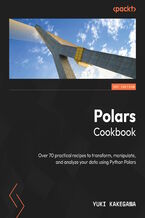Python Natural Language Processing Cookbook. Over 50 recipes to understand, analyze, and generate text for implementing language processing tasks Zhenya Antić




- Autor:
- Zhenya Antić
- Serie wydawnicze:
- Cookbook
- Wydawnictwo:
- Packt Publishing
- Ocena:
- Stron:
- 284
- Dostępne formaty:
-
PDFePubMobi
Opis
książki
:
Python Natural Language Processing Cookbook. Over 50 recipes to understand, analyze, and generate text for implementing language processing tasks
Starting with an overview of NLP, the book presents recipes for dividing text into sentences, stemming and lemmatization, removing stopwords, and parts of speech tagging to help you to prepare your data. You’ll then learn ways of extracting and representing grammatical information, such as dependency parsing and anaphora resolution, discover different ways of representing the semantics using bag-of-words, TF-IDF, word embeddings, and BERT, and develop skills for text classification using keywords, SVMs, LSTMs, and other techniques. As you advance, you’ll also see how to extract information from text, implement unsupervised and supervised techniques for topic modeling, and perform topic modeling of short texts, such as tweets. Additionally, the book shows you how to develop chatbots using NLTK and Rasa and visualize text data.
By the end of this NLP book, you’ll have developed the skills to use a powerful set of tools for text processing.
Wybrane bestsellery
Zobacz pozostałe książki z serii Cookbook
Packt Publishing - inne książki
Dzięki opcji "Druk na żądanie" do sprzedaży wracają tytuły Grupy Helion, które cieszyły sie dużym zainteresowaniem, a których nakład został wyprzedany.
Dla naszych Czytelników wydrukowaliśmy dodatkową pulę egzemplarzy w technice druku cyfrowego.
Co powinieneś wiedzieć o usłudze "Druk na żądanie":
- usługa obejmuje tylko widoczną poniżej listę tytułów, którą na bieżąco aktualizujemy;
- cena książki może być wyższa od początkowej ceny detalicznej, co jest spowodowane kosztami druku cyfrowego (wyższymi niż koszty tradycyjnego druku offsetowego). Obowiązująca cena jest zawsze podawana na stronie WWW książki;
- zawartość książki wraz z dodatkami (płyta CD, DVD) odpowiada jej pierwotnemu wydaniu i jest w pełni komplementarna;
- usługa nie obejmuje książek w kolorze.
Masz pytanie o konkretny tytuł? Napisz do nas: sklep@helion.pl
Książka drukowana











































Oceny i opinie klientów: Python Natural Language Processing Cookbook. Over 50 recipes to understand, analyze, and generate text for implementing language processing tasks Zhenya Antić
(0)